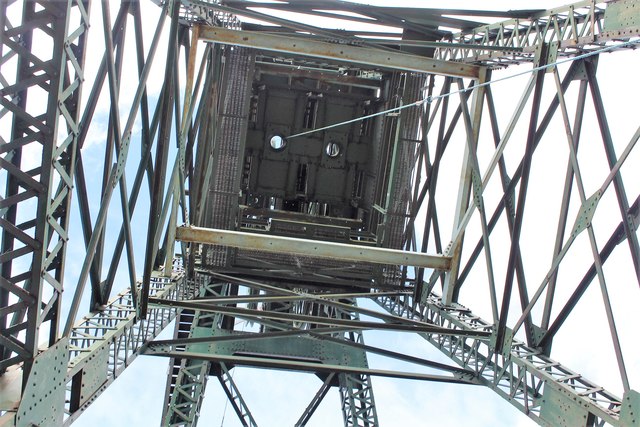SJ3148 : The headgear at Bersham Colliery from below
taken 6 years ago, near to Rhostyllen, Wrexham/Wrecsam, Wales

Originally from the nearby Gatewen Colliery.
Restored with the help of Heritage Lottery Funding.
Coal was a vital raw material for industry and its plentiful supply locally (the Denbighshire Coalfield extends from Oswestry to north of Wrexham) transformed Wrexham from a market town into the industrial centre for North-East Wales. Villages like Rhosllanerchrugog, Ponciau and Llay grew up as the coal mining industry expanded in the 19th Century. In coal's heyday, there were 38 collieries employing over 12,000 men and coal production topped 2.6 million tons. This coal powered the growth of the local iron industry from the mid-eighteenth century. Other industries such as the brick, tile and terracotta works of Abenbury and Ruabon also needed coal. In the 20th century the Shotton steelworks used Bersham’s coal.
In 1855 and 1859 Llanrafon Farm, Rhostyllen was up for sale with ''valuable seams of coal or ironstone''.
A colliery shaft, originally named Glan-yr-Afon (Riverside), was sunk in 1864 on the site of the old brickworks adjacent to the Shrewsbury to Chester railway line however due to difficulties it did not reach the main seams.
In 1868 Messrs J.G & W. Barnes of Liverpool bought the colliery and established the Bersham Colliery Co.
It had been left empty for six years until in 1871 when the shafts were deepened to reach the main seams. Number 1 upshaft had a diameter of 10 feet and reached 420 yards deep. Number 2 shaft had a diameter of 12 feet and reached 421 yards deep. You can still see the small cage on top of the No.1 Shaft, which took miners and equipment down to the coalface and back.
The first coal was raised in 1874. In 1878 the main seam was reached 380 metres (416 yards) underground.
It was dangerous work. In 1875 there was a gas explosion and one miner was killed. An explosion in 1880 killed 9 workers.
By 1902 the original owners, the Barnes family from Liverpool, employed 675 men below ground and 94 more at the surface.
The large metal structure on the site is called the Headgear. Now restored,with the help of the Heritage Lottery Fund, it came from nearby Gatewen Colliery. The headgear was brought to Bersham Colliery for the No.2 Shaft in 1930 after a fire destroyed the former timber-built structure.
The headgear helped to lift the coal up the No.2 Shaft from the coalface 1269 feet / 387 metres below. It also lowered and lifted men and equipment to and from the tunnels connected to the coalface. The brick building next to the Headgear houses the electric winding machine that pulled the lift cage containing the coal to the surface.
The underground seams spread as far as Erddig and caused the country house to subside and eventually forced Philip Yorke, the owner, to move out and hand the property over to the National Trust. The mine had to leave the coal seams in the area of Erddig in place, which adversely affected the viability of the pit. The National Coal Board paid the trust compensation of £120,000 to stabilise the building through underpinning.
Pit ponies were used until 1954 being replaced with mechanisation.
Bersham Colliery overcame many problems: some of the coal seams were less than 2 foot high, the mine was wet, the Wrexham - Staffordshire fault made life difficult and there was always a problem in getting the coal up from the face to the surface quick enough. There was an ingenious machine that blew the coal up a pipe as powder to be sold on to the power station at Fiddlers Ferry. However, Bersham was an efficient mine to run despite a preference for economies of scale in the coal industry. The colliery was at its largest in 1958 with 1,011 on site.
Bersham Colliery was the last working colliery in the Denbighshire Coalfield. It was closed down in 1986 with the loss of 480 jobs.
It is a legally protected Scheduled Ancient Monument in the care of Wrexham County Borough Council and Bersham Colliery Trust. The engine house is a Grade II listed building.
